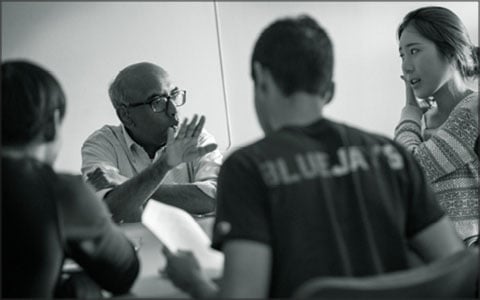Tilak Ratnanather, associate research professor of biomedical engineering at Johns Hopkins, has earned a reputation as a remarkable scientist, researcher, role model, and mentor.
Born with probable damage to his inner ear, Ratnanather was fitted with hearing aids at an early age and attended schools for the deaf through high school. His family moved from Sri Lanka to London due to England’s superior system of education for the deaf. Ratnanather attended University College London, where he became its first congenitally, profoundly deaf student to pursue an undergraduate degree in mathematics.
He then entered the DPhil mathematics program at the University of Oxford, where, in 1989, he completed his doctoral research in numerical analysis of fluid flows. That was another first. At the time, Ratnanather was the only congenitally and profoundly deaf individual in the world to graduate with a doctorate in mathematics.
In 1990, Tilak crossed paths with Bill Brownell, a professor in the Department of Otolaryngology — Head and Neck Surgery at the Johns Hopkins University School of Medicine. Brownell recruited Ratnanather to do postdoctoral studies in his department and in Biomedical Engineering under Aleksander Popel, with a focus on hearing biomechanics. Tilak made his mark as an expert and a major contributor, especially in the area of mathematical modeling of electromechanical transduction by outer hair cells in the cochlea.
Neuroimaging, Computational Anatomy, and Cranial Biomarkers
Over the years and with developments in neuroimaging, Ratnanather’s research moved beyond focusing on the inner ear and into the brain. Since 1998, he’s been an integral part of the Whiting School’s Center for Imaging Science, performing an acrobatic mix of geometry, advanced computations, and data analysis necessary to map the intricacies of the human brain. He is an expert in numerical analysis and the convergence of various computing approaches.
Using computational anatomy, Ratnanather and his colleagues have been probing the specific structural differences — or biomarkers — between healthy brains and those afflicted with maladies from ADHD to mental illness. Recently, the team was able to pinpoint structural differences in the amygdala, hippocampus, and entorhinal cortex — the region responsible for memory — in subjects with preclinical Alzheimer’s.
“The idea is that if you pinpoint the location where the damage is happening, a drug could one day be developed to stop atrophy in that region of the brain,” says Ratnanather. “Imaging is becoming a very powerful tool for developing biomarkers. That research could be carried over to other diseases, such as Huntington’s, Parkinson’s, depression, schizophrenia, and even to issues of speech and language.”
Becoming a Catalyst for Widening STEM Opportunities for Hearing-Challenged Students
When Tilak Ratnanather attended his first meeting of the Association for Research in Otolaryngology (ARO) in 1992, he was just one of three hearing-impaired researchers out of the hundreds attending the conference. Missing from the conference was closed captioning. This triggered Ratnanather and other hearing-impaired attendees to form a subgroup, the HI-ARO (Hearing Impaired Association of Research in Otolaryngology). In addition to improving accessibility for the hearing impaired at the conference, the group has become an informal mentoring network for the hearing impaired — connecting researchers to opportunities.
At that time, there were just two deaf or hard-of-hearing individuals pursuing graduate degrees in auditory sciences worldwide. Deaf and hard-of-hearing students have traditionally been underrepresented in STEM fields at the undergraduate and graduate levels.
Ratnanather thinks this is simply bad for science. He believes that those who might be the most effective at doing the research to help the deaf are the deaf themselves. Helping the hearing impaired succeed in the demanding STEM field will lead to greater and more profound advances in auditory research.
To that end, Ratnanather, who has a reputation for his warmth and congeniality, regularly acts a matchmaker — pairing students up with researchers for internships, or making mutually beneficial introductions at conferences and symposiums.
He has mentored dozens of students, many of them deaf or hard of hearing. His mentees have gone on to pursue careers as engineers, researchers, and physicians around the globe.
Since Ratnanather and others have started their mentoring movement, the number of deaf researchers in the auditory sciences has expanded significantly. In 2015, there were 10 hearing-impaired faculty members in the auditory sciences nationwide, with another 15 pursuing graduate programs in the field.
— Adapted from an article by Joe Sugarman for the Whiting School of Engineering.

